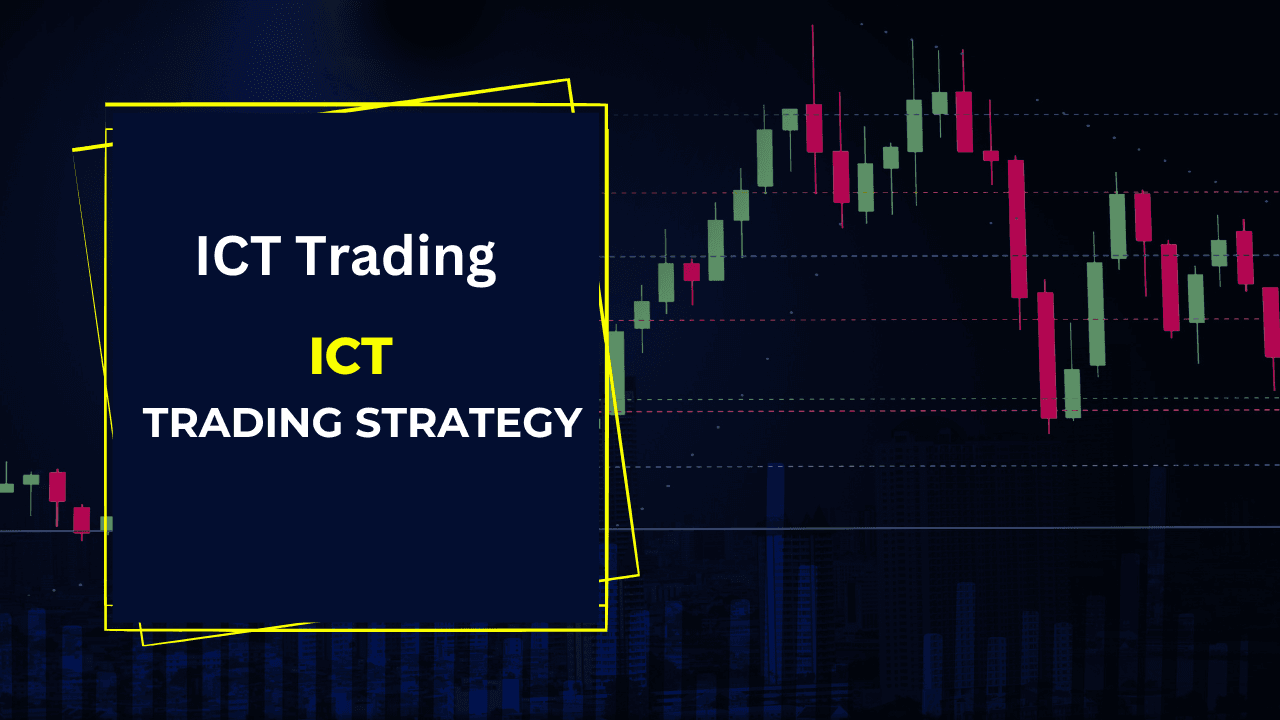In today’s fast-paced financial markets, having a solid trading strategy is crucial for success. One such strategy that has gained significant attention is the ICT Trading Strategy. Developed by the Inner Circle Trading (ICT) community, this approach emphasizes a deep understanding of market dynamics, price action, and liquidity. This article will explore the ICT Trading Strategy in detail, helping both novice and experienced traders leverage its principles for profitable trading. By the end, you’ll have a clear understanding of what this strategy entails and how to implement it effectively.
Introduction of ICT Trading Strategy
The ICT Trading Strategy is designed to help traders understand and navigate the complexities of financial markets. Unlike traditional trading methods that rely heavily on indicators and automated systems, this strategy focuses on price action and the underlying market structure. The essence of ICT lies in recognizing the flow of liquidity and identifying key price levels where buying and selling interest converge.
The ICT Trading Strategy is grounded in the belief that understanding market psychology is essential for making informed trading decisions. It encourages traders to observe how prices move in relation to support and resistance levels, which are pivotal points that can indicate potential reversals or continuations in the market. By mastering this strategy, traders can make more educated decisions based on market behavior rather than mere speculation.
Furthermore, the ICT Trading Strategy encompasses various elements, including order blocks, market structure, and liquidity concepts. Each component plays a vital role in developing a comprehensive trading plan that enhances a trader’s ability to predict price movements and execute trades effectively.
What is ICT Trading Strategy?
The ICT Trading Strategy refers to a systematic approach to trading that focuses on understanding the intricate workings of the market. This strategy aims to identify opportunities based on price action, market structure, and the behavior of institutional traders. At its core, the ICT Trading Strategy emphasizes the following key principles:
Key Principles of ICT Trading Strategy
- Price Action: This is the core of the ICT Trading Strategy. It involves analyzing historical price movements to predict future behavior. Traders observe how prices react at key levels, helping them make better trading decisions.
- Market Structure: Understanding the market structure is crucial for implementing the ICT Trading Strategy effectively. Traders learn to recognize patterns, trends, and phases within the market, enabling them to identify potential entry and exit points.
- Order Blocks: Order blocks are significant areas where buying or selling pressure has previously occurred. Recognizing these blocks allows traders to anticipate where price reversals may happen, making them essential for successful trades.
- Liquidity Concepts: The ICT Trading Strategy emphasizes understanding where liquidity exists in the market. This understanding helps traders identify high-probability trade setups and manage risk effectively.
Core Components of ICT Trading Strategy
The ICT Trading Strategy comprises several core components that work together to help traders navigate the complexities of the financial markets. Understanding these components is essential for effectively implementing the strategy and maximizing trading success. Here are the key elements of the ICT Trading Strategy:
Market Structure
Market structure refers to the organization of price movements over time. It helps traders identify trends, reversals, and ranges in the market. By understanding market structure, traders can anticipate potential price movements and make informed decisions.
- Trends: Recognizing whether the market is in an uptrend, downtrend, or ranging is crucial. In an uptrend, prices are making higher highs and higher lows, while in a downtrend, prices make lower highs and lower lows. Identifying these trends can help traders align their trades with the market’s momentum.
- Phases: The market goes through various phases, including accumulation, distribution, and retracement. Understanding these phases allows traders to spot opportunities to enter or exit trades.
Price Action
Price action is a vital component of the ICT Trading Strategy. It focuses on the movement of prices and helps traders make decisions based on historical data rather than relying solely on indicators.
- Support and Resistance Levels: These levels are crucial in price action analysis. Support levels indicate where buying interest may emerge, while resistance levels show where selling pressure could arise. Traders use these levels to set entry and exit points for their trades.
- Candlestick Patterns: Observing candlestick patterns can provide insights into market sentiment. Patterns like pin bars, engulfing candles, and dojis can indicate potential reversals or continuations in the market.
Order Blocks
Order blocks are significant price areas where institutional traders have placed large buy or sell orders. Understanding order blocks is essential for anticipating price reversals and market moves.
- Identifying Order Blocks: Traders learn to identify these blocks by looking for areas on the chart where price has made a significant move after a period of consolidation. These areas often act as strong support or resistance levels in the future.
- Trading with Order Blocks: Once identified, traders can use order blocks to set entry points for trades. Entering near an order block increases the likelihood of a successful trade, as these areas often attract significant buying or selling interest.
Liquidity Concepts
Liquidity refers to the availability of buyers and sellers in the market. Understanding liquidity is crucial for executing trades effectively and managing risk.
- Liquidity Pools: Traders learn to identify liquidity pools—areas where there is a concentration of orders. These pools can influence price movements, making them key locations for trade setups.
- Impact on Price Movement: Recognizing how liquidity impacts price movement allows traders to anticipate potential breakouts or reversals. By understanding where liquidity is likely to be, traders can position themselves advantageously in the market.
How to Use ICT Trading Strategy
Now that we’ve explored the core components of the ICT Trading Strategy, let’s discuss how to effectively use this strategy in your trading. Implementing the ICT Trading Strategy involves several key steps that can enhance your trading performance.
Analyzing Market Conditions
Before placing any trades, it’s essential to analyze the current market conditions. This analysis involves:
- Evaluating the Trend: Determine whether the market is in an uptrend, downtrend, or ranging. This evaluation helps align your trades with the market direction.
- Identifying Key Levels: Look for significant support and resistance levels based on historical price action. These levels will help you set entry and exit points for your trades.
Developing a Trading Plan
Having a structured trading plan is critical for successful trading with the ICT Trading Strategy. Your trading plan should include:
- Clear Objectives: Define your trading goals, including profit targets and risk tolerance.
- Entry and Exit Criteria: Establish rules for when to enter and exit trades. This could be based on market structure, price action, or order blocks.
- Risk Management: Determine your position size and risk per trade. This helps protect your capital and ensures you can withstand losing streaks.
Entry and Exit Strategies
Executing trades based on your analysis and trading plan is where the ICT Trading Strategy comes to life.
- Setting Entry Points: Use order blocks and support/resistance levels to determine where to enter trades. Look for price action signals, such as candlestick patterns, that indicate a potential reversal or continuation.
- Establishing Exit Points: Determine your exit points based on your trading plan. Consider using a trailing stop-loss or profit targets based on market structure to maximize your gains.
Case Studies and Examples
Real-world examples and case studies can provide valuable insights into how the ICT Trading Strategy works in practice.
- Analyzing Successful Trades: Look at past trades that aligned with the ICT Trading Strategy. Analyze the reasons for their success and the decision-making process involved.
- Learning from Mistakes: Reviewing trades that didn’t go as planned is equally important. Identify what went wrong and how you can improve your approach in the future.
Advantages of ICT Trading Strategy
The ICT Trading Strategy offers several advantages that make it a compelling choice for traders looking to enhance their trading performance. Understanding these benefits can help you appreciate why many traders have adopted this approach. Here are the key advantages of the ICT Trading Strategy:
Enhanced Market Understanding
One of the primary benefits of the ICT Trading Strategy is its emphasis on a comprehensive understanding of market dynamics. By focusing on price action, market structure, and liquidity concepts, traders gain deeper insights into how the market operates. This knowledge allows traders to:
- Anticipate Market Moves: A solid grasp of market behavior enables traders to predict potential price movements more accurately.
- Make Informed Decisions: Understanding the underlying factors that influence price action helps traders avoid impulsive decisions based on emotions.
Flexibility and Adaptability
The ICT Trading Strategy is adaptable to various market conditions, making it suitable for different trading styles and timeframes.
- Applicability to Multiple Markets: Whether you’re trading forex, stocks, or commodities, the principles of the ICT Trading Strategy can be applied across different markets.
- Tailored Approaches: Traders can customize the strategy to fit their unique trading preferences, allowing for both short-term and long-term trading approaches.
Risk Management
Effective risk management is crucial for successful trading, and the ICT Trading Strategy places a strong emphasis on this aspect.
- Structured Risk Management Techniques: The strategy encourages traders to set clear risk parameters, helping them protect their capital and minimize losses.
- Improved Discipline: Following a structured trading plan based on the ICT Trading Strategy fosters discipline, reducing the likelihood of emotional trading decisions.
Community Support and Resources
Being part of the ICT community provides traders with access to valuable resources and support.
- Learning Opportunities: Traders can learn from experienced members of the community through forums, webinars, and training sessions.
- Shared Insights: Engaging with other traders allows for the exchange of ideas, strategies, and insights, enhancing overall trading knowledge.
Common Mistakes to Avoid
While the ICT Trading Strategy offers numerous advantages, traders can also fall into common pitfalls that hinder their success. Being aware of these mistakes can help you avoid them and improve your trading performance. Here are some of the most common mistakes to avoid:
Ignoring Market Structure
One of the fundamental aspects of the ICT Trading Strategy is understanding market structure. A common mistake is neglecting to analyze the market’s phases, which can lead to poor trading decisions.
- Failure to Recognize Trends: Not identifying whether the market is in an uptrend or downtrend can result in trades that go against the prevailing market direction.
- Disregarding Key Levels: Ignoring important support and resistance levels can lead to entering trades at unfavorable prices.
Overtrading
Overtrading is a frequent mistake among traders, often stemming from emotional decision-making.
- Chasing Losses: Traders may feel compelled to take excessive trades to recover losses, leading to further financial setbacks.
- Lack of Patience: Impatience in waiting for high-probability setups can result in entering trades that do not align with the ICT Trading Strategy principles.
Inadequate Risk Management
Effective risk management is vital for long-term success, and many traders overlook this crucial aspect.
- Ignoring Stop-Loss Orders: Failing to set stop-loss orders can expose traders to significant losses if the market moves against them.
- Not Assessing Position Sizes: Taking on positions that are too large relative to one’s account size can lead to rapid capital depletion.
Neglecting Continuous Learning
The financial markets are constantly evolving, and neglecting to stay informed can hinder a trader’s progress.
- Resisting Adaptation: Sticking rigidly to outdated strategies without adapting to new market conditions can lead to missed opportunities.
- Failure to Review Performance: Not analyzing past trades to identify patterns and mistakes prevents traders from learning and improving.
Resources for Learning More About ICT
To fully grasp the ICT Trading Strategy and enhance your trading skills, it’s essential to leverage various resources available for traders. These resources can provide valuable insights, knowledge, and support to help you navigate the complexities of the financial markets. Here are some of the best resources for learning more about Inner Circle Trading (ICT):
Books
Several books offer in-depth knowledge about trading principles, strategies, and psychology that align with the ICT Trading Strategy. Here are a few highly recommended titles:
- “Trading in the Zone” by Mark Douglas: This book focuses on the psychology of trading and helps traders develop the right mindset for success.
- “Technical Analysis of the Financial Markets” by John J. Murphy: A comprehensive guide to technical analysis, this book covers various concepts relevant to understanding price action.
- “The Inner Circle Trader” by Michael J. Huddleston: As the founder of the ICT community, Huddleston shares insights into his trading philosophy and strategies.
Online Courses and Webinars
Participating in online courses and webinars is an effective way to gain structured knowledge about the ICT Trading Strategy. Look for courses that cover:
- Market Structure Analysis: Courses focusing on understanding market phases and trends can provide essential knowledge for applying the ICT Trading Strategy.
- Price Action Trading: Learning how to read price action effectively will enhance your trading decisions and strategies.
- Risk Management Techniques: Courses that emphasize risk management can help you develop effective trading plans.
Community and Forums
Joining a community of traders can significantly boost your learning experience. Online forums and social media groups dedicated to ICT offer:
- Support and Networking: Engaging with other traders allows you to share insights, ask questions, and receive feedback on your trading strategies.
- Access to Live Discussions: Participating in live discussions can provide real-time insights into market conditions and trading opportunities.
- Mentorship Opportunities: Experienced traders in the ICT community may offer mentorship, helping you refine your trading skills.
YouTube Channels and Podcasts
YouTube channels and podcasts can be valuable sources of information on the ICT Trading Strategy. Some notable mentions include:
- ICT’s Official YouTube Channel: Michael Huddleston shares valuable content, tutorials, and trading insights directly from the founder of ICT.
- Trading Psychology Podcasts: Podcasts focusing on trading psychology can help you understand the mental aspects of trading and how to maintain discipline.
Conclusion
In conclusion, the ICT Trading Strategy offers a comprehensive approach to trading that emphasizes a deep understanding of market dynamics, price action, and risk management. By mastering its core components and implementing the strategy effectively, traders can significantly enhance their chances of success in the financial markets.
Remember that continuous learning is essential for growth in trading. Utilize the resources available to you, including books, online courses, community support, and engaging content on platforms like YouTube and podcasts. By remaining dedicated to improving your skills and knowledge, you can navigate the complexities of trading with confidence.
Embrace the journey of mastering the ICT Trading Strategy, and take the steps necessary to achieve your trading goals. With discipline, patience, and a solid understanding of the principles behind ICT, you can position yourself for long-term success in the dynamic world of trading.
Read More ICT Turtle Soup Setup- A Quick Guide
Frequently Asked Questions
What is the ICT Trading Strategy?
The ICT Trading Strategy, developed by Michael J. Huddleston of the Inner Circle Trading community, focuses on understanding market dynamics, price action, and liquidity concepts. It emphasizes analyzing market structure and employing risk management techniques to enhance trading performance across various markets.
Is the ICT Trading Strategy suitable for beginners?
Yes, the ICT Trading Strategy can be suitable for beginners, but it requires a willingness to learn and practice. New traders should start by understanding the core concepts, such as market structure and price action, before implementing the strategy in live trading.
How can I start learning about ICT Trading?
You can start learning about the ICT Trading Strategy by exploring various resources, including books, online courses, and YouTube channels. Engaging with the ICT community through forums and social media can also provide valuable insights and support.
What are the key components of the ICT Trading Strategy?
The key components of the ICT Trading Strategy include market structure analysis, price action trading, order blocks, and liquidity concepts. These elements work together to help traders make informed decisions and improve their overall trading performance.
How important is risk management in ICT Trading?
Risk management is crucial in the ICT Trading Strategy. Effective risk management techniques, such as setting stop-loss orders and determining appropriate position sizes, help protect your capital and ensure long-term success in trading.


